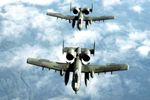
original at www.af.mil |
A-10 Thunderbolt II
(U.S. Air Force photo)
The first production A-10A was delivered to Davis-Monthan Air Force Base, Ariz., in October 1975. It was designed specially for the close air support mission and had the ability to combine large military loads, long loiter and wide combat radius, which proved to be vital assets to America and its allies during Operation Desert Storm. In the Gulf War, A-10s, with a mission capable rate of 95.7 percent, flew 8,100 sorties and launched 90 percent of the AGM-65 Maverick missiles. |
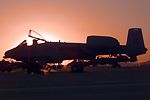
original at www.af.mil |
Bushwhacker '97 at Davis-Monthan AFB, Arizona
(U.S. Air Force photo by Senior Amn. Jennifer Gangemi)
An A-10 from the 354th Fighter Squadron is dramatically depicted during Bushwhacker '97 at Davis-Monthan AFB, Arizona. |

original at www.af.mil |
A-10A fires Maverick missile
(U.S. Air Force photo)
The first production A-10A was delivered to Davis-Monthan Air Force Base, Ariz., in October 1975. It was designed specially for the close air support mission and had the ability to combine large military loads, long loiter and wide combat radius, which proved to be vital assets to America and its allies during Operation Desert Storm. In the Gulf War, A-10s, with a mission capable rate of 95.7 percent, flew 8,100 sorties and launched 90 percent of the AGM-65 Maverick missiles. The A-10 and OA-10 Thunderbolt IIs are the first Air Force aircraft specially designed for close air support of ground forces. They are simple, effective and survivable twin-engine jet aircraft that can be used against all ground targets, including tanks and other armored vehicles. |
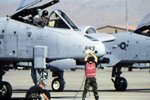
original at www.af.mil |
A-10 flightline maintenance in action
(U.S. Air Force photo by Staff Sgt. David Nichols)
The A-10 and OA-10 Thunderbolt IIs are the first Air Force aircraft specially designed for close air support of ground forces. They are simple, effective and survivable twin-engine jet aircraft that can be used against all ground targets, including tanks and other armored vehicles. The A-10/OA-10 have excellent maneuverability at low air speeds and altitude, and are highly accurate weapons-delivery platforms. They can loiter near battle areas for extended periods of time and operate under 1,000-foot ceilings (303.3 meters) with 1.5-mile (2.4 kilometers) visibility. Their wide combat radius and short takeoff and landing capability permit operations in and out of locations near front lines. Using night vision goggles, A-10/ OA-10 pilots can conduct their missions during darkness. Thunderbolt IIs have Night Vision Imaging Systems (NVIS), compatible single-seat cockpits forward of their wings and a large bubble canopy which provides pilots all-around vision. The pilots are encircled by titanium armor that also protects parts of the flight-control system. The redundant primary structural sections allow the aircraft to enjoy better survivability during close air support than did previous aircraft. The aircraft can survive direct hits from armor-piercing and high-explosive projectiles up to 23mm. Their self-sealing fuel cells are protected by internal and external foam. Their redundant hydraulic flight-control systems are backed up by manual systems. This permits pilots to fly and land when hydraulic power is lost. The Thunderbolt II can be serviced and operated from bases with limited facilities near battle areas. Many of the aircraft's parts are interchangeable left and right, including the engines, main landing gear and vertical stabilizers. |

original at www.af.mil |
A-10 Thunderbolt II Closeup
(U.S. Air Force photo)
The A-10 and OA-10 Thunderbolt IIs are the first Air Force aircraft specially designed for close air support of ground forces. They are simple, effective and survivable twin-engine jet aircraft that can be used against all ground targets, including tanks and other armored vehicles. The A-10/OA-10 have excellent maneuverability at low air speeds and altitude, and are highly accurate weapons-delivery platforms. They can loiter near battle areas for extended periods of time and operate under 1,000-foot ceilings (303.3 meters) with 1.5-mile (2.4 kilometers) visibility. Their wide combat radius and short takeoff and landing capability permit operations in and out of locations near front lines. Using night vision goggles, A-10/ OA-10 pilots can conduct their missions during darkness. Thunderbolt IIs have Night Vision Imaging Systems (NVIS), compatible single-seat cockpits forward of their wings and a large bubble canopy which provides pilots all-around vision. The pilots are encircled by titanium armor that also protects parts of the flight-control system. The redundant primary structural sections allow the aircraft to enjoy better survivability during close air support than did previous aircraft. The aircraft can survive direct hits from armor-piercing and high-explosive projectiles up to 23mm. Their self-sealing fuel cells are protected by internal and external foam. Their redundant hydraulic flight-control systems are backed up by manual systems. This permits pilots to fly and land when hydraulic power is lost. |
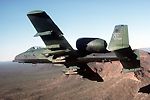
original at www.af.mil |
A-10A Thunderbolt II in Nevada
(U.S. Air Force photo)
The A-10 and OA-10 Thunderbolt IIs are the first Air Force aircraft specially designed for close air support of ground forces. They are simple, effective and survivable twin-engine jet aircraft that can be used against all ground targets, including tanks and other armored vehicles. The A-10/OA-10 have excellent maneuverability at low air speeds and altitude, and are highly accurate weapons-delivery platforms. They can loiter near battle areas for extended periods of time and operate under 1,000-foot ceilings (303.3 meters) with 1.5-mile (2.4 kilometers) visibility. Their wide combat radius and short takeoff and landing capability permit operations in and out of locations near front lines. Using night vision goggles, A-10/ OA-10 pilots can conduct their missions during darkness. |

original at www.af.mil |
Cobalt Flash - A-10s re-deploy to Germany
(U.S. Air Force photo by Senior Amn Diane Robinson)
11/09/1998 - An A-10, Warthog, pilot takes another look at flight plans before taking off, as the 81st Fighter Squadron, Spangdalem AB, Germany, redeploys from Aviano Air Base, Italy. Operation Cobalt Flash, in support of Joint Forge, is winding down after Serbian forces continue to comply with terms set by NATO. |
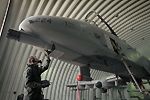
original at www.af.mil |
Senior Airman David Switzer, Aero Repair Journeyman
(U.S. Air Force photo by Technical Sgt. Lance Cheung)
Senior Airman David Switzer, an aero repair journeyman, at Osan AB, Korea, inspects an OA-10 Thunderbolt II, observation and attack jet fighter, for proper panel fitting after a retraction check. |
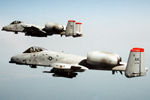
original at www.af.mil |
355th Fighter Squadron A-10A Thunderbolt IIs
(U.S. Air Force photo by Technical Sgt. John McDowell)
A-10A Thunderbolt IIs from the 355th Fighter Squadron, Eielson Air Force Base, Alaska, fly over the coast of South Korea at the Kunsan Bomb Range. The A-10s are returning from a live ordinance bomb drop. The A-10 and OA-10s are the first Air Force aircraft specially designed for close air support of ground forces. They are simple, effective and survivable twin-engine jet aircraft that can be used against all ground targets, including tanks and other armored vehicles. The A-10/OA-10 have excellent maneuverability at low air speeds and altitude, and are highly accurate weapons-delivery platforms. They can loiter near battle areas for extended periods of time and operate under 1,000-foot ceilings (303.3 meters) with 1.5-mile (2.4 kilometers) visibility. Their wide combat radius and short takeoff and landing capability permit operations in and out of locations near front lines. Using night vision goggles, A-10/ OA-10 pilots can conduct their missions during darkness. |
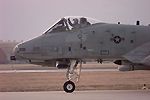
original at www.af.mil |
81st Fighter Squadron A-10 Thunderbolt pilot
(U.S. Air Force photo by Senior Airman Jeffrey Allen)
An A-10 Thunderbolt from the 81st Fighter Squadron, Spangdahlem Air Base, Germany taxis to the runway before taking off from Aviano Air Base, Italy, in support Operation Allied Force. |
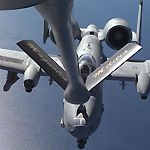
original at www.af.mil |
A-10 Thunderbolt II from the 52nd Fighter Wing refuels
(U.S. Air Force photo)
An A-10 Thunderbolt II from the 52nd Fighter Wing, Spangdahlem Air Base, Germany, refuels from a KC-135 Stratotanker flown by the 186th Air Refueling Wing, Meridian, Miss., on Feb. 26, 1999. The 186th and the 52nd are deployed to Aviano AB, Italy supporting Kosovo-related operations. (990226-F-2171A-011) |

original at www.af.mil |
355th Fighter Squadron A-10
(U.S. Air Force photo by Tech. Sgt. David W. Richards)
An A/OA-10 Thunderbolt II assigned to the 355th Fighter Squadron, Eielson Air Force Base, Alaska, moves in position under and slightly behind a KC-135R Stratotanker from the 168th Air Refueling Squadron, Alaska Air National Guard to commence refueling operations in support of Exercise Northern Edge. (990309-F-2829R-005) |
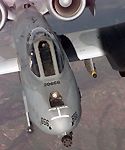
original at www.af.mil |
Allied Force - Close-up of A-10 Thunderbolt II
(U.S. Air Force Photo by Senior Airman Greg Davis)
A U.S. Air Force A-10 Thunderbolt II flies in formation moments before dropping away from a refueling tanker. The A-10 is headed for a strike on targets in Yugoslavia in support of NATO Operation Allied Force on Thursday, April 22, 1999. The A-10 is assigned to the 52nd Fighter Wing, 81st Fighter Squadron, Spangdahlem Air Base, Germany, but is flying missions from its deployed location at Aviano Air Base, Italy. The military objective is to deter further Serbian attacks against the people of Kosovo and reduce the ability of the Serbian military forces to continue their offensive operations against the people of Kosovo. Fourteen NATO countries are currently contributing to Operation Allied Force. |
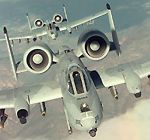
original at www.af.mil |
Allied Force - A-10s refuel before strike
(U.S. Air Force photo by Senior Airman Greg L. Davis)
Two U.S. Air Force A-10 Thunderbolt IIs fly in formation moments before dropping away from a refueling tanker. The A-10s are headed for a strike on targets in Yugoslavia in support of NATO Operation Allied Force on Thursday, April 22, 1999. The A-10s are assigned to the 52nd Fighter Wing, 81st Fighter Squadron, Spangdahlem Air Base, Germany, but are flying missions from their deployed location at Aviano Air Base, Italy. The military objective is to deter further Serbian attacks against the people of Kosovo and reduce the ability of the Serbian military forces to continue their offensive operations against the people of Kosovo. Fourteen NATO countries are currently contributing to Operation Allied Force. |

original at www.af.mil |
SSgt. Chris Almeria, 25th Fighter Squadron, Osan Air Base, Korea
(U.S. Air Force photo by Technical Sgt. Lance Cheung)
Staff Sgt. Chris Almeria, a jet engine specialist from Middletown, N.Y., with the 25th Fighter Squadron from Osan Air Base, Korea, inspects the canopy of an OA-10A Thunderbolt II at Suwon Air Base, Korea, on Monday, May 17, 1999. The 51st Fighter Wing is based at Osan but is operating at Suwon during runway renovations. |

original at www.af.mil |
OA-10A Thunderbolt IIs of the 25th Fighter Squadron
(U.S. Air Force photo by Technical Sgt. Lance Cheung)
Weapons load crew members safe the weapons of one of their returning OA-10A Thunderbolt IIs of the 25th Fighter Squadron Assam Dragons on Monday, May 17, 1999, at Suwon Air Base, Korea. The 51st Fighter Wing is based at Osan Air Base, Korea, but some aircraft are operating at Suwon during runway renovations at Osan. |

original at www.af.mil |
A-10 Thunderbolt II from Spangdahlem Air Base
(U.S. Air Force photo by Senior Master Sgt. Rose Reynolds)
An A-10 Thunderbolt II from the 52nd Fighter Wing, Spangdahlem Air Base, Germany flies over southern Germany. A-10s are the first Air Force aircraft specially designed for close air support of ground forces. They are simple, effective and survivable twin-engine jet aircraft that can be used against all ground targets, including tanks and other armored vehicles. The A-10 has excellent maneuverability at low air speeds and altitude, and are highly accurate weapons-delivery platforms. They can loiter near battle areas for extended periods of time and operate under 1,000-foot ceilings (303.3 meters) with 1.5-mile (2.4 kilometers) visibility. Their wide combat radius and short takeoff and landing capability permit operations in and out of locations near front lines. |
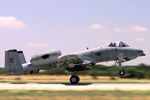
original at www.af.mil |
A-10 Thunderbolt II takes off from Italy
(U.S. Air Force photo Tech. Sgt. Blake R. Borsic)
An A-10 Thunderbolt II from Spangdahlem Air Base, Germany, takes off from Gioia Del Colle Air Base, Italy. A-10s are the first Air Force aircraft specially designed for close air support of ground forces. They are simple, effective and survivable twin-engine jet aircraft that can be used against all ground targets, including tanks and other armored vehicles. The A-10s have excellent maneuverability at low air speeds and altitude, and are highly accurate weapons-delivery platforms. They can loiter near battle areas for extended periods of time and operate under 1,000-foot ceilings (303.3 meters) with 1.5-mile (2.4 kilometers)visibility. Their wide combat radius and short takeoff and landing capability permit operations in and out of locations near front lines. |
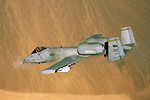
original at www.af.mil |
OA/A-10 Thunderbolt II Opens Fire
(U.S. Air Force Photo by Staff Sgt. Steve Thurow)
The A-10 and OA-10 Thunderbolt IIs are the first Air Force aircraft specially designed for close air support of ground forces. They are simple, effective and survivable twin-engine jet aircraft that can be used against all ground targets, including tanks and other armored vehicles. These aircraft are highly accurate weapons-delivery platforms, with excellent maneuverability at low air speeds and altitude. The Thunderbolt II's 30mm GAU-8/A Gatling gun can fire 3,900 rounds a minute and can defeat an array of ground targets to include tanks. The USAF Weapons School, headquartered at Nellis AFB, NV, teaches graduate-level instructor courses, providing the world's most advanced training in weapons and tactics employment to officers of the combat air forces. |

original at www.af.mil |
A-10 Thunderbolt II at work
(U.S. Air Force Photo Staff Sgt. Steve Thurow)
The A-10 and OA-10 Thunderbolt IIs are the first Air Force aircraft specially designed for close air support of ground forces. They are simple, effective and survivable twin-engine jet aircraft that can be used against all ground targets, including tanks and other armored vehicles. The A-10/OA-10 have excellent maneuverability at low air speeds and altitude, and are highly accurate weapons-delivery platforms. They can loiter near battle areas for extended periods of time and operate under 1,000-foot ceilings (303.3 meters) with 1.5-mile (2.4 kilometers) visibility. Their wide combat radius and short takeoff and landing capability permit operations in and out of locations near front lines. Using night vision goggles, A-10/ OA-10 pilots can conduct their missions during darkness. |

original at www.af.mil |
A-10 Thunderbolt II at sunset
(U.S. Air Force Photo by Senior Amn. Greg Davis)
The A/OA-10 Thunderbolt II is the first Air Force aircraft specially designed for close air support of ground forces. They are simple, effective and survivable twin-engine jet aircraft that can be used against all ground targets, including tanks and other armored vehicles. The A-10/OA-10 have excellent maneuverability at low air speeds and altitude, and are highly accurate weapons-delivery platforms. They can loiter near battle areas for extended periods of time and operate under 1,000-foot ceilings (303.3 meters) with 1.5-mile (2.4 kilometers) visibility. Their wide combat radius and short takeoff and landing capability permit operations in and out of locations near front lines. Using night vision goggles, A-10/ OA-10 pilots can conduct their missions during darkness. Thunderbolt IIs have Night Vision Imaging Systems (NVIS), goggle compatible single-seat cockpits forward of their wings and a large bubble canopy which provides pilots all-around vision. The pilots are protected by titanium armor that also protects parts of the flight-control system. The redundant primary structural sections allow the aircraft to enjoy better survivability during close air support than did previous aircraft. |
^^ TOP ^^
|

